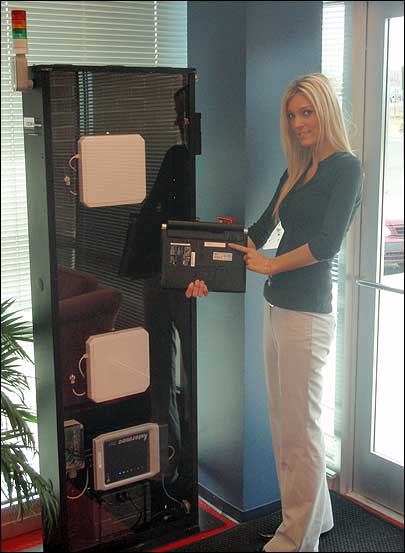When visitors arrive at the new headquarters and laboratory of RFID services provider and systems integrator ODIN Technologies in Ashburn, Va., they are met at the door by an RFID interrogator deployed by the company to track its own assets, and those of its clients. The reader is part of an RFID-based security and asset-tracking installation that Patrick J. Sweeney, ODIN’s president and CEO, calls “eating our own dog food.”
Designed by ODIN, the system utilizes Intermec fixed readers, as well as handheld interrogators from Intermec and Motorola, enabling the company to track its own assets, as well as those of its clients, throughout the 11,000-square-foot building. The system also employs ODIN’s EasyMonitor software, which tracks the readers’ health by measuring read performance, along with InSync‘s asset management and inventory software, that provides such business processes as matching assets with employees and sending alerts. The data is then stored in ODIN’s SQL database.

ODIN Technologies celebrated the opening of the new facility in December 2008 (see ODIN Technologies Opens New RFID Lab) to test passive RFID technology systems for its clients. The lab simulates real-world environments for customers seeking an RFID solution, a large percentage of which work for the U.S. Department of Defense.
Designing its own RFID system for asset tracking and security provides three functions, Sweeney says: security for its own and its clients’ assets, a reduction in hours previously spent by employees conducting manual inventory checks, and proof that the systems ODIN sells are able to work in the real world.
In the case of security, many of ODIN’s clients bring in equipment that is either highly valuable, at a high risk for theft, or a threat to public safety or national security, such as servers, heart catheters or weapons. “We often work with equipment that is sensitive to national security,” Sweeney states.
Another reason ODIN was prompted to adopt the RFID system was its desire to control its own inventory as the company grows along with the number of assets. The firm reports that its 2008 revenues were 125 percent higher than those of 2007; as a result, ODIN has hired additional employees and acquired more assets. With that growth, it became increasingly cumbersome to track each item, such as electronics kept in storage closets or allocated to employees, or to conduct an inventory of all equipment at ODIN’s previous office and lab, a task the company undertook only once each year. With RFID, Sweeney says, inventory-taking could now be accomplished monthly or quarterly.
With the new solution, each employee is provided with an RFID-enabled ID badge encoded and printed on a Zebra Technologies printer. The passive UHF EPC Gen 2 chip in the card stores a unique ID number linked to the employee’s name and picture in ODIN’s back-end system using InSync software. To date, Odin has attached RFID tags to approximately 100 assets, including IP phones and laptops. Like the badges, each asset tag contains an EPC Gen 2 tag encoded with a unique ID number that is linked, in the database, not only to such data as the item’s description and serial number, but also with the picture and name of the worker assigned access to that particular asset.
When an employee carries a tagged asset through one of the facility’s two doors (each of which is equipped with an IF61 Intermec reader), the asset’s ID number, as well as the worker’s badge data, is captured and transmitted to the InSync software system via a cabled connection. If someone attempts to remove that item from the building without authorization, the software detects an unexpected action, and it records the incident, along with the time and date it occurred, to be reviewed by the staff. According to Sweeney, in the next phase (currently in development), the system will alert security personnel via e-mail, as well as sound an audible alarm.
For inventory purposes, an employee can use an Intermec or Motorola handheld reader to sweep through the facility, locating each item and capturing its ID number to confirm that it is on the premises.
If clients bring their own assets to the lab for RFID testing, they can request that ODIN fit those items with RFID tags, which would trigger an alert if one of the assets were to leave the site. However, Sweeney says, because the items are being put through tests of RFID technology in the laboratory, the tags are designed to be easily removed in the lab so that they will not interfere with testing.
ODIN intends to install a similar system at its Dublin and Budapest locations sometime this year, Sweeney says. In addition, for the second phase of the Ashburn RFID installation, the company is testing RTLS solutions from Mojix and RF Control that would include an array of reader antennas that would send RF beams throughout the laboratory and other work areas, in order to capture ID numbers on the tags and use triangulation to pinpoint the items’ locations.
In the past month, ODIN has conducted “a ton of tours and briefings,” Sweeney says. “We find people are highly receptive to seeing the technology as soon as they walk in,” he explains, indicating many visitors liked seeing RFID technology in use at the building. By employing the technology itself, he adds, ODIN can demonstrate to its customers that RFID works, and that the company is benefiting from its use. “Any client looking to buy RFID technology should ask the vendor, do you use this solution?”

